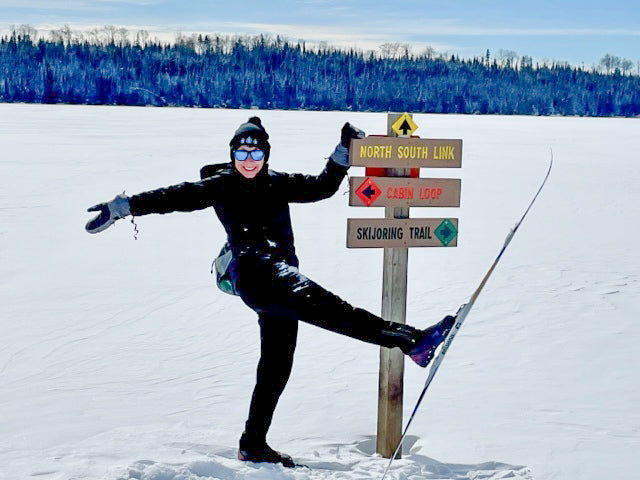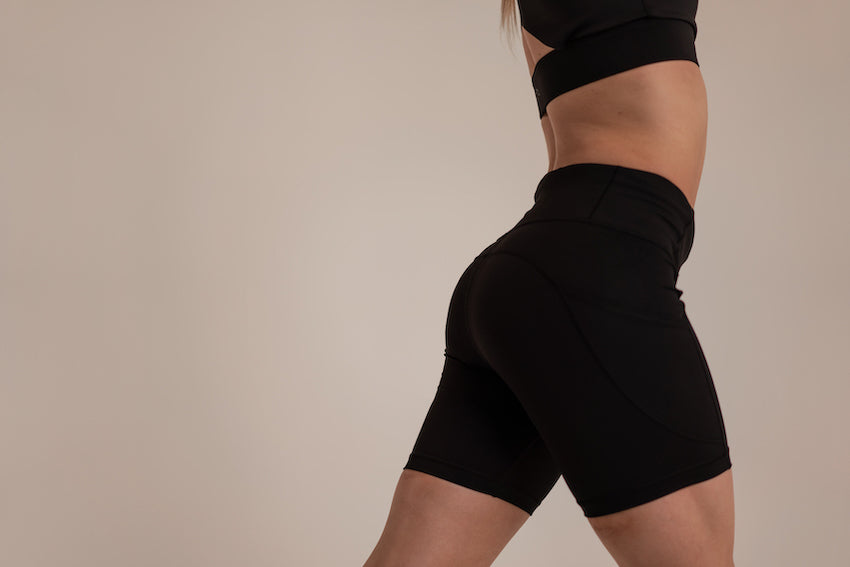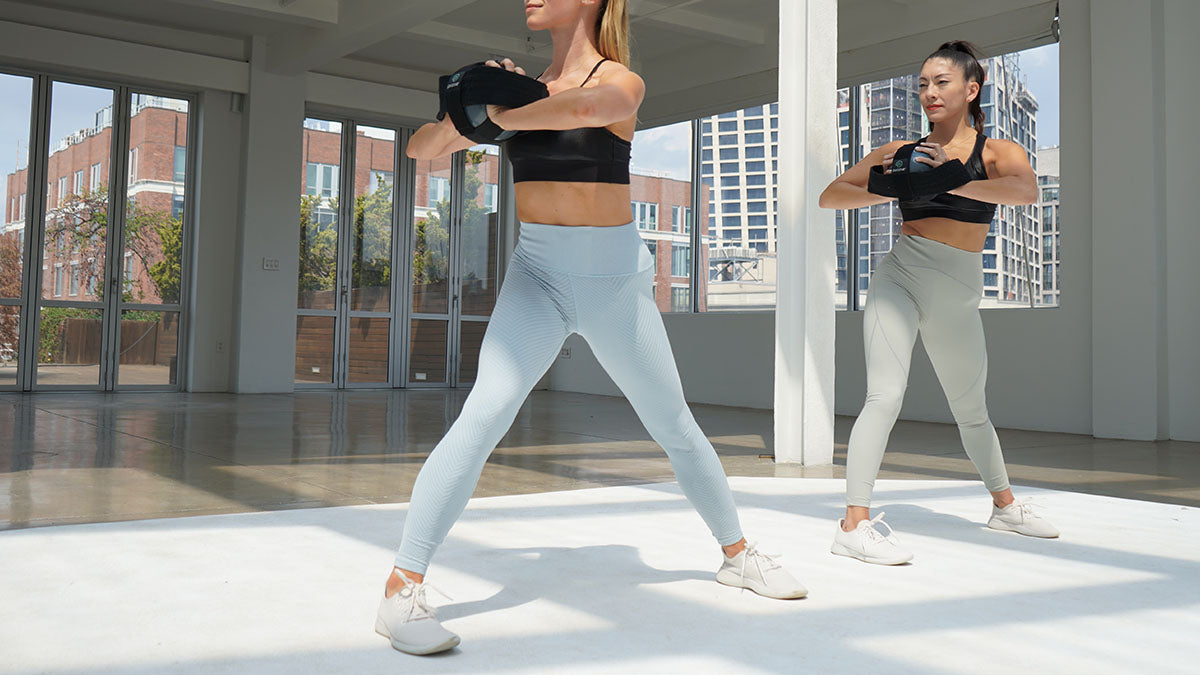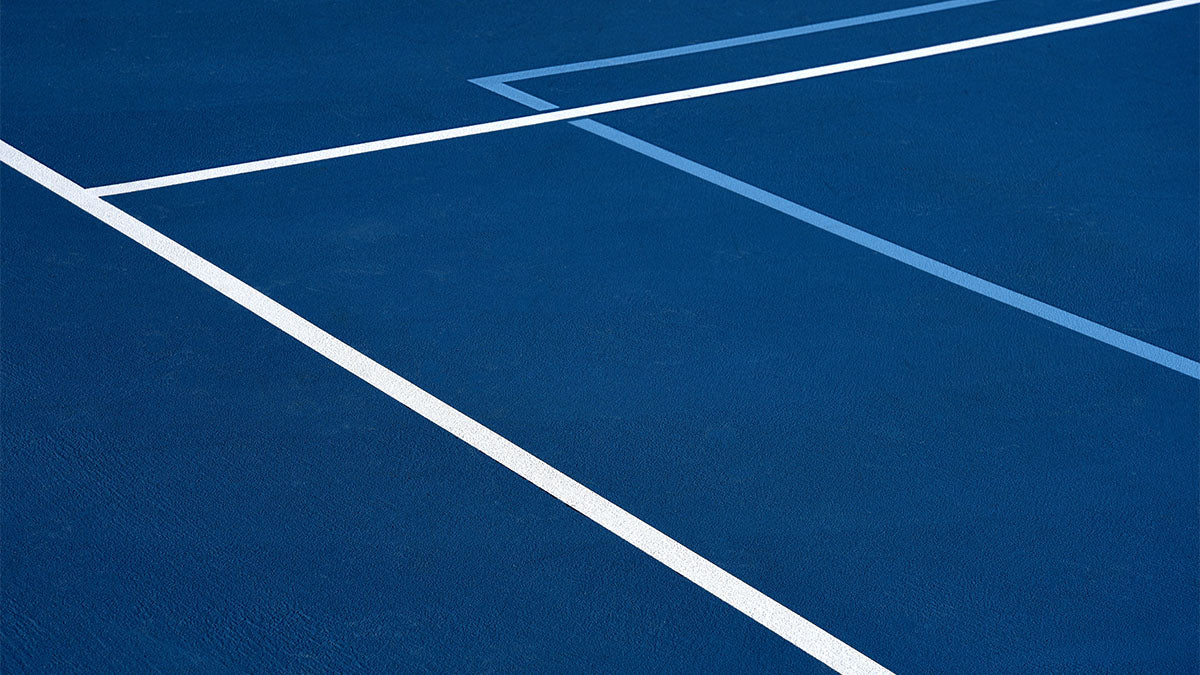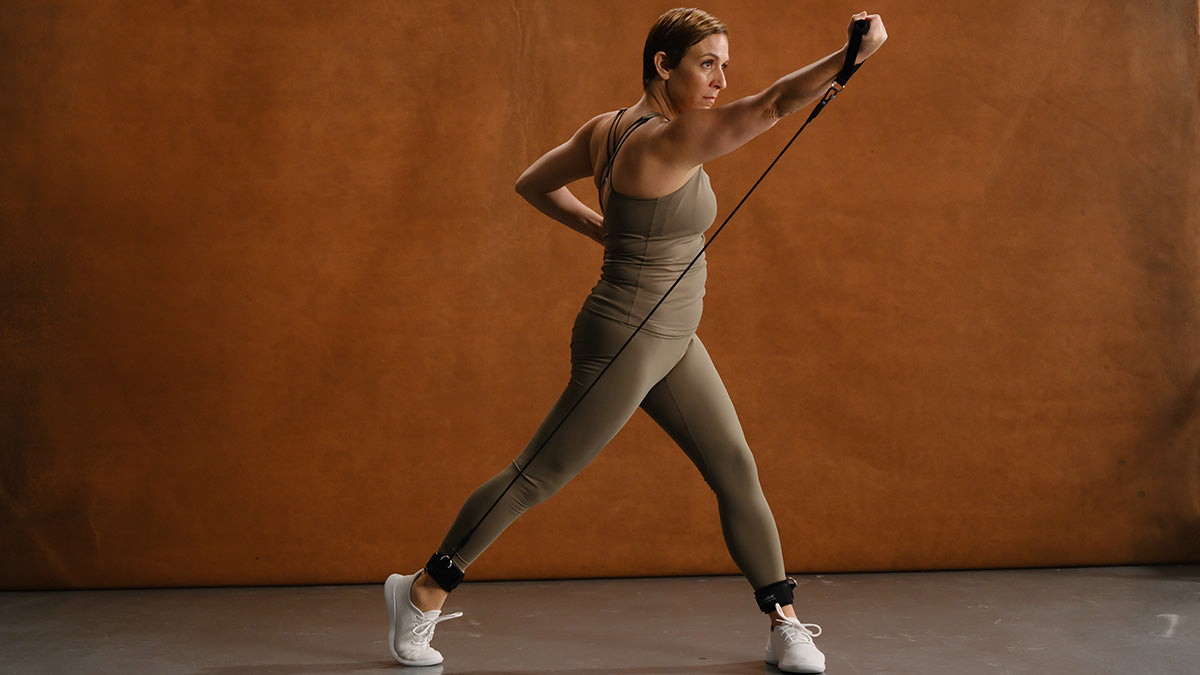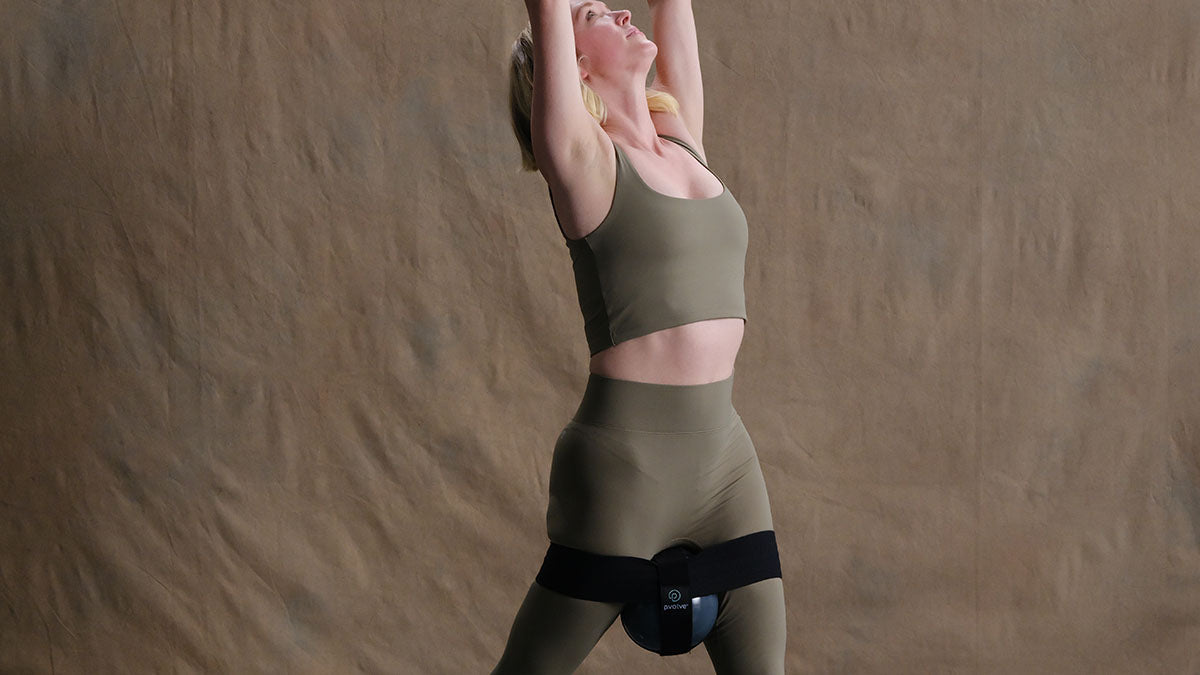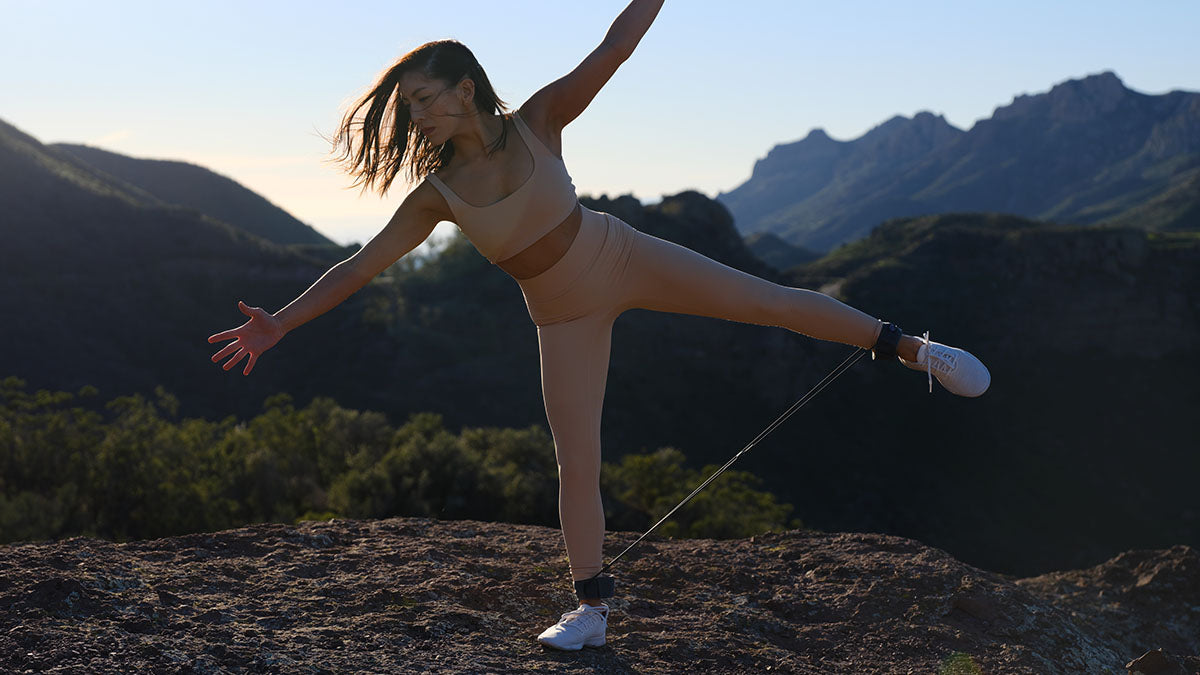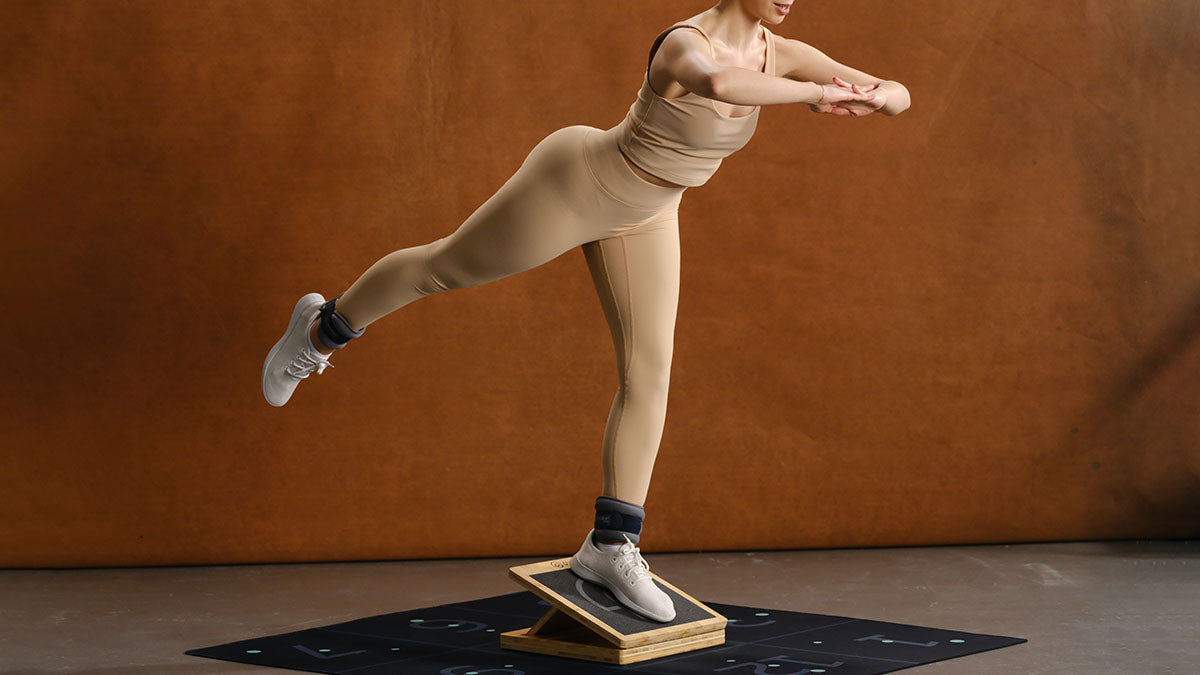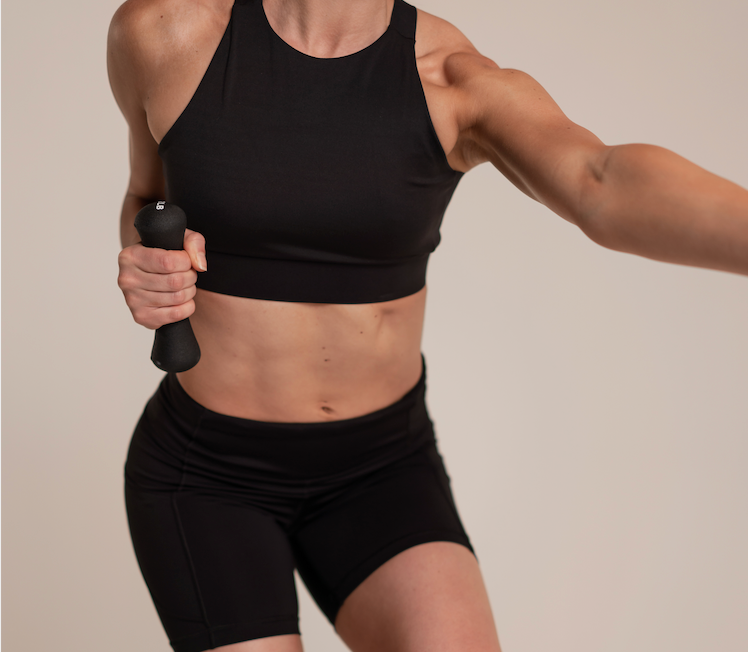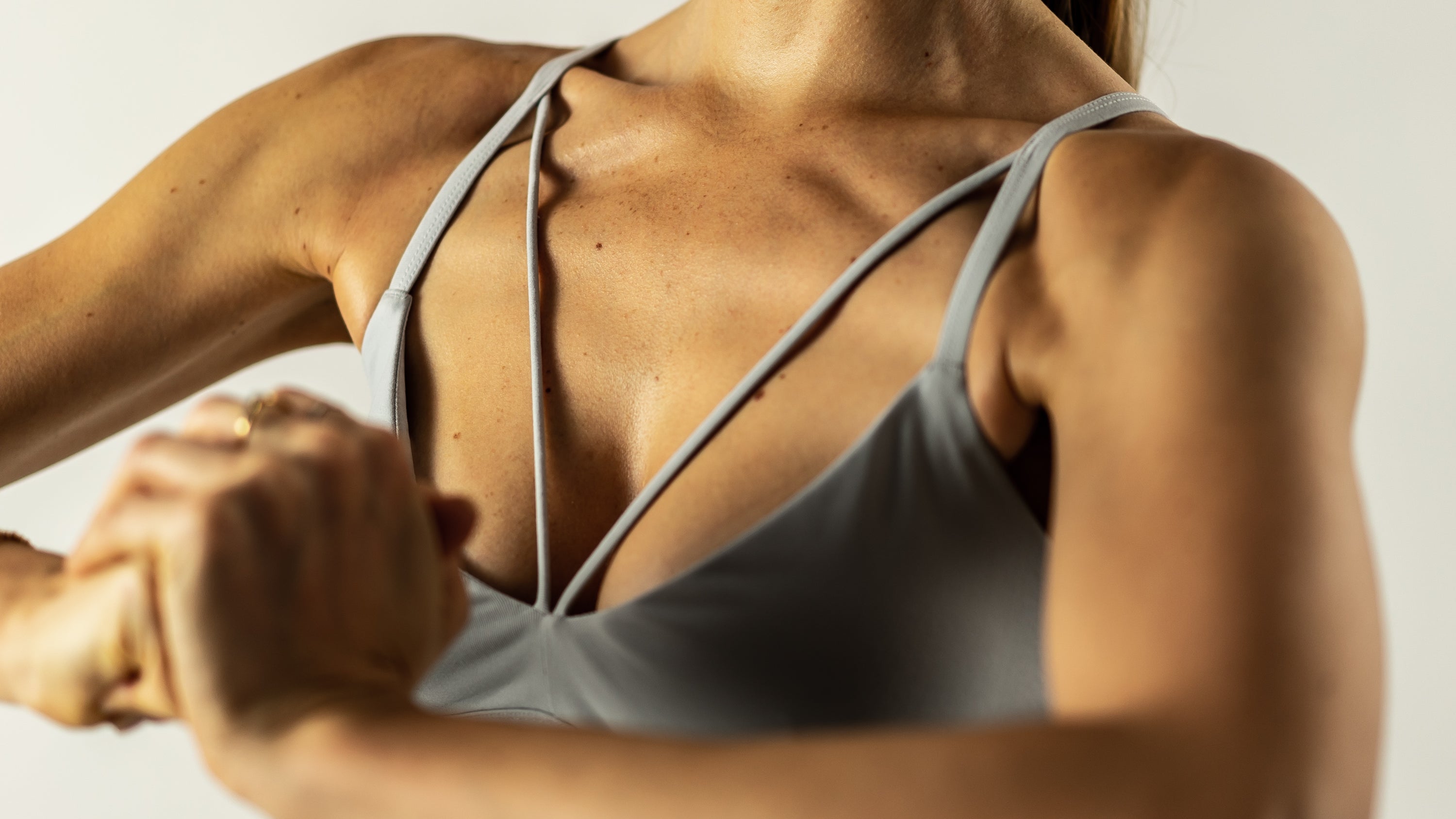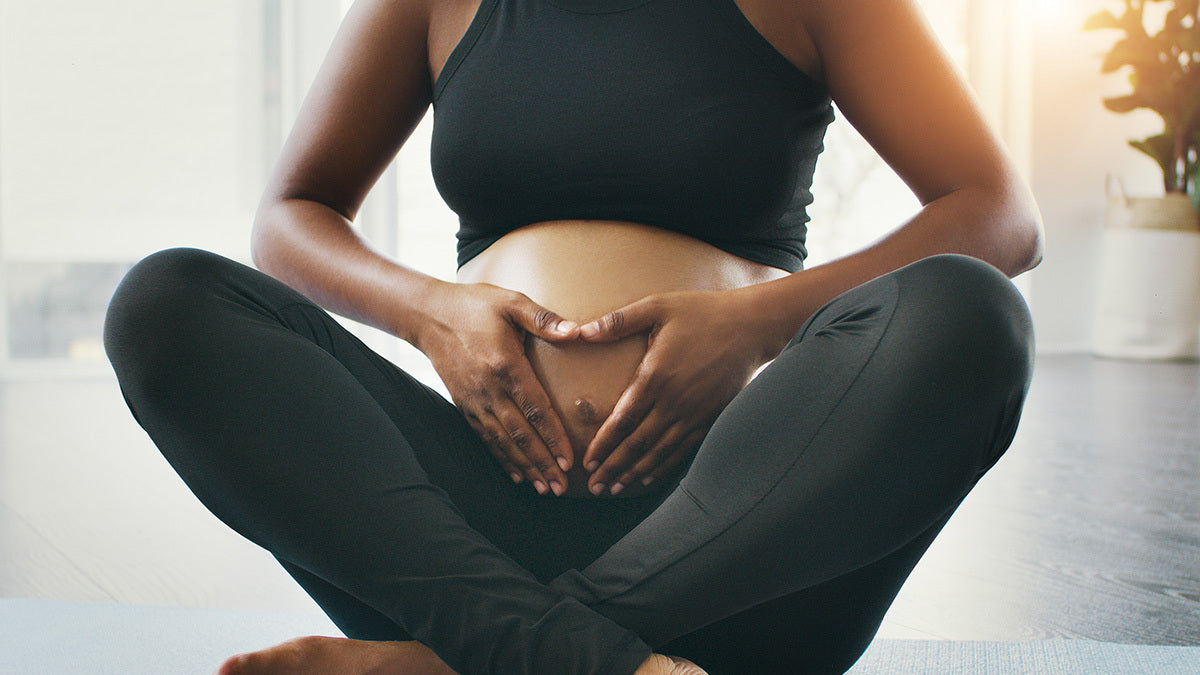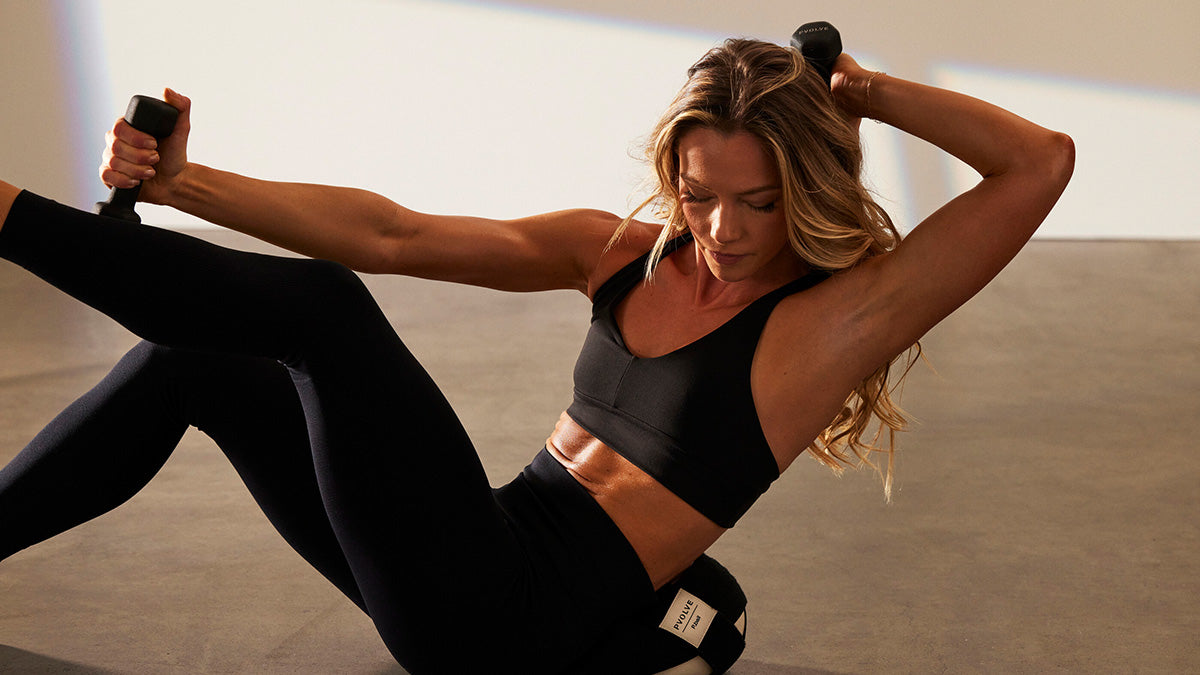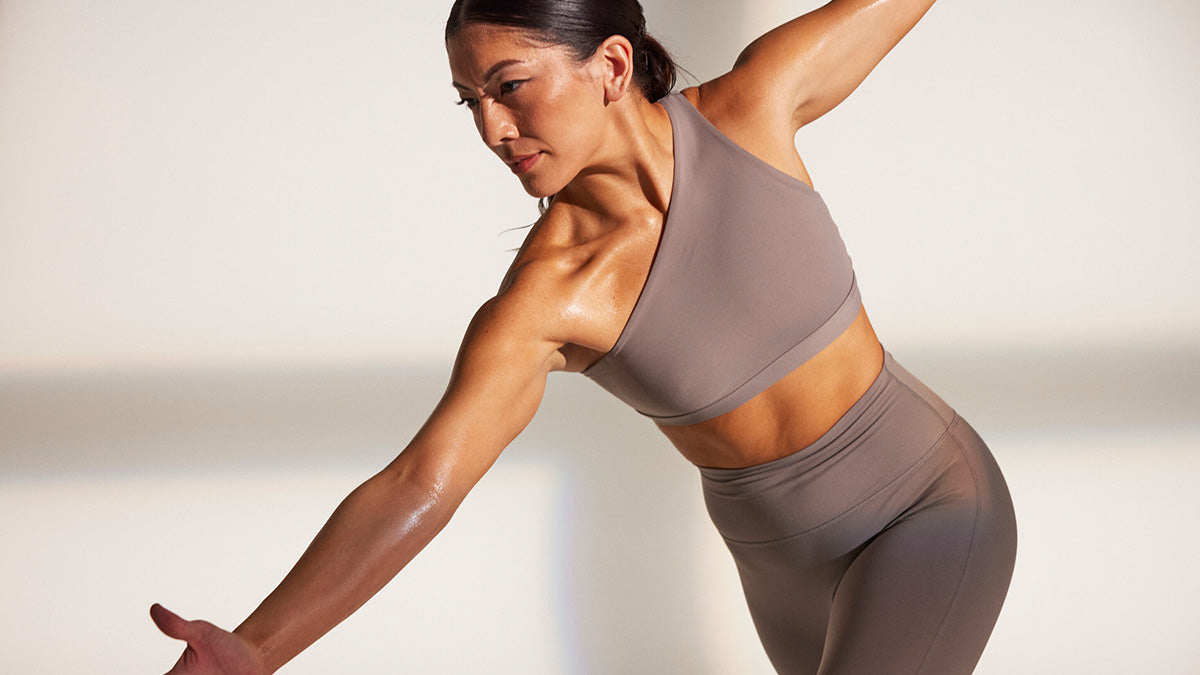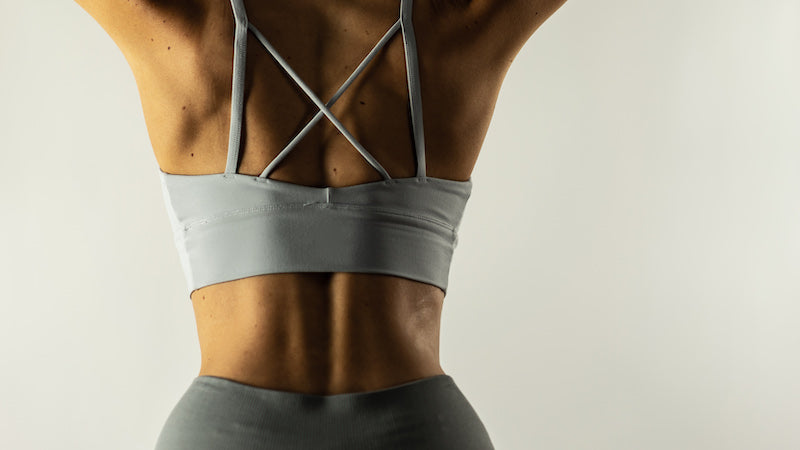-
Shop
SAVE UP TO $218 W/CODE FF15Shop Our Best-Selling Equipment + Streaming BundlesBundle and save on equipment plus streaming-the best way to experience the Pvolve Method at home. Not sure which bundle to get? Take our 2-minute quiz to find your perfect bundle.

- Learn
- at home
- in studio
- franchise
“I'm getting the results I've always wanted” - Laura M.
Fed up with feeling sore from her workouts, Laura M., 53, hoped to get a low-impact (but still effective!) workout with Pvolve. The method didn’t disappoint. When it comes to working out, I’ve tried it all, starting with Jane Fonda aerobics back in the ’80s. My exercise journey has led me to activities I love (cross-country skiing and hiking with my dog!). But I’ve also had my share of misses, like HIIT and CrossFit classes that left me sore and limping about. And even though the workouts were tough, I wasn’t getting the results I wanted. Instead, I just felt puffy. Flash forward to May 2020. I had just turned 50 and I was ready for something that checked two boxes: gentle and effective. A Google search (“exercises that are nice on your body”) led me to the Pvolve Method, and I decided to give it a try. It was the early days of the pandemic—and I live in Minnesota—so an at-home class was my only option. Pressing play on that first workout was one of the best things I could do for my body. The Class That Changed Everything There are multiple ways to experience Pvolve: in-person classes, live virtual studio workouts, and streaming classes. I started with the pre-recorded sessions. My first reaction was that the moves felt good. (Box #1, check!) But I'm the type of person who tends to slack off when exercising solo, and I knew I wasn’t giving 100%. I missed having real-time encouragement. I played roller derby for four years, so I do like to be pushed! I decided to try a Live Virtual Studio class, where you can keep your camera on (if you choose to), allowing the instructors to watch your form and provide in-the-moment feedback. That’s when it all clicked. Having a trainer’s eyes on me encouraged me to push myself a bit harder. It also made me realize that my form had been off. The trainers called that out (“Laura, rotate your ankle slightly to the left” or “Laura, raise your arms a little higher”). Once I nailed the technique, I discovered just how intense a Pvolve workout can be. Box #2, check! A Bone-Boosting Routine I’m postmenopausal and already have osteoporosis, so I have to take my bone health into consideration when working out. I love the Progressive Weight Training series, which helps to build muscle and improve bone density—so important for women my age. And the fact that Pvolve trainers provide modifications for so many moves has made all the difference for me, because there are certain exercises that I just can’t physically do. I used to feel like my workouts tore my body apart, but Pvolve is restorative. Whether my body needs strengthening, stretching, or something else, there’s a Pvolve workout that fits that need. And the equipment has helped me tap into muscles that were long ignored in my previous workouts. I remember using the P.ball for the first time and feeling my abs engage in a completely new way. Strong for Life Pvolve doesn’t stop once class ends; I keep the method in mind during everyday activities and when I’m exercising outdoors. During a recent cross-country skiing outing, for example, I focused on knitting in my ribcage and rolling my shoulders back (two cues I learned from these workouts). Those tweaks made me feel stronger than ever on my skis. Instead of relying on my legs to propel myself through the snow, now I was tapping into my core strength too. These days, I do Pvolve about twice a week. I’m proud of the results! My arms are toned, my clothes fit better, and people compliment me on how fit I look. But it’s how I feel that matters most. Pvolve is a safe space for my body, and I’m so thankful to have found it. 5 of my Pvolve highlights 1. Finally finding a feel-good workout Pvolve trainers push you to be your best, but they never push you to do anything that could hurt you. I’m in my 50s and have orthopedic concerns, so that’s important for me! 2. Feeling the virtual community love I may work out by myself at home, but I feed off the energy from the instructors and other members during each live virtual studio class. 3. Perfecting my form Pvolve moves are different from your go-to gym exercises, but once you master the technique, you’ll feel—and see—the difference. 4. Using Pvolve moves outside of class I tap into what I learn in class when I’m out cross-country skiing. It’s made me a stronger skier! 5. Newfound strength I’ve been able to strengthen areas of my body where I used to have instabilities. It makes everyday tasks, like walking down the stairs, easier.
How Can I Prevent Dormant Butt Syndrome?
Strange but true: Your butt may need a wake-up call. For people with dormant butt syndrome—also known as gluteal amnesia or dead butt syndrome—the glutes have essentially pressed the snooze button and aren’t firing properly. And when your butt muscles don’t work as they should, other areas of the body may have to pick up the slack, which could lead to injuries. But you don’t need to live with lazy buttocks! Dr. Amy Hoover, Pvolve’s Chief Physical Therapist and member of the Clinical Advisory Board, explains how to give your glutes a kick in the, er, butt to get them to activate correctly and fix your dormant butt syndrome. WHAT IS DORMANT BUTT SYNDROME? Dormant butt syndrome is a term used to describe an imbalance of the muscles surrounding the hip. A dormant butt occurs when there’s weakness and underactivity in the glutes due to tightness and overuse of the hip flexors, which prevent the glutes from turning on correctly. A desk job or long commute could be to blame, since one of the top causes of dead butt syndrome is prolonged sitting. Over time, when the glutes are restricted from working correctly, they weaken and become “dormant.” This puts more stress on the lower back, hip, and pelvic joints due to lack of support from the large muscles of the glutes. HOW TO SPOT DORMANT BUTT SYNDROME Dormant butt syndrome doesn’t happen overnight. Since muscles and movement patterns change slowly over time, it can be hard to notice when your glutes stop firing correctly, but there are signs to look out for. Most often, dormant butt syndrome manifests as pain or tightness that limits your activity or ability to move the way you want to. Weakness in the gluteals can lead to increased stress on the lower leg, knee, and IT band, so you may experience pain in the knees. Additionally, tightness in the hip flexors can cause anterior pelvic tilt and increased tightness in the lower back, leading to lower back pain. HOW CAN YOU FIX DORMANT BUTT SYNDROME? One good way to prevent dormant butt syndrome is to avoid sitting for hours on end. Aim to get up from your chair or the couch and move around once an hour. But avoiding weakness in the hips and tight hip flexors is best done through mindful movement and targeted, whole body functional strengthening. The Pvolve Method, which is rooted in functional movement, targets this area specifically to help you move the way your body was designed to. Think of it this way: We don’t move in one plane, so we shouldn’t exercise in one plane either. For example, doing squats to strengthen the hips does not take into account pivoting, moving sideways, or turning. This is where the Pvolve Method shines. Moving mindfully through multiple planes helps to turn on muscles in a way that reteaches our body to use optimal muscle patterns—including your glutes. THE BEST EXERCISES FOR DORMANT BUTT SYNDROME Performing moves that involve internal and external hip rotation as well as using equipment such as Gliders, ankle bands, and the P.ball will target the whole hip area. Hip opening stretches and hip flexor stretches or recovery workouts that target the hips and pelvis can also help improve and maintain mobility in the hips. The great news is that your Pvolve routines work these exact muscles, helping them activate correctly so that you can fix dormant butt syndrome. 5 MOVES TO STRENGTHEN THE GLUTES Fire up your backside with these dormant butt syndrome exercises. HIP HINGE Stand with feet slightly wider than hip distance and hands clasped by your face. Slightly bend your knees to hinge at your hips, drawing your glutes back so your torso is on a long diagonal while simultaneously unclasping hands and driving arms behind you. Be sure to keep your spine long and abs pulled in to prevent arching in the back. Return to start position. Do 8-10 reps. STEP BACK AND REACH Start in hip hinge position with abdominals engaged, spine long from head to your tailbone, flexion in the front of the hips, and arms outstretched in front of you. Imagine you’re standing at 12 on a clock and step your right leg straight back to 6 o’clock, keeping your heel lifted and pressing down through your toes to engage your right calf and glute. Sweep arms forward and up towards the ceiling without swaying or arching in the lower back. Hold the stretch for a moment and then press your arms back down in front of you while pushing down into your front foot to shift your weight and return your right foot back to your p.sit position. Do 8-10 reps, then switch sides. INTERNAL 45 Start with feet hip-distance apart, arms at chest height with fingers interlaced and elbows out, and hinge at hips into a p.sit. Imagine you’re standing at 12 o’clock on a clock, then shift weight into your left leg while internally rotating the pelvis to step your right leg back to 5 o’clock, pushing into your big toe to lengthen your right leg and keeping your right heel lifted (your hips should rotate to point towards 11 o’clock). Squeeze your inner thighs together to engage your right back glute, then scoop the core in to return to start position. Do 8-10 reps, then switch sides. OPEN STEP SIT BACK Start in p.sit position and imagine you’re standing at 12 o’clock on a clock. Shift your weight into your left foot while sweeping your right foot open towards 3 or 5 o’clock. (If you have a precision mat, your right foot should be parallel to horizontal lines on it.) . Keeping knees stacked over your ankles, spine straight, and abs engaged, guide your hips back a few inches to create a slightly deeper crease, then pause for a moment. Staying in this p.sit position, lift up from the smile line of your glutes to open hips, then crease again. Do 8-10 reps, then return to your p.sit and switch sides. SOCCER KICK Stand with hips square, right foot slightly in front of left, arms above the head with light weights in hands. Lengthen the right leg and tap toes forward while leaning slightly back to create one long diagonal line through the body from your right toes out the crown of your head, avoiding arching in your lower back, angling the hip bones up toward the ceiling, and squeezing the glutes. Lower arms to shoulder height, keeping them straight, while straightening back to neutral and raising the right knee toward ceiling. Then extend the arms up and lean slightly back while tapping the right foot forward. Do 10-12 reps, then switch sides.
Sculpt and Tone with the P.ball
It’s full-body workout in one clever little piece of equipment. The P.ball is a unique workout tool that was originally created to sculpt and tone the inner thighs, but as the Pvolve Method evolved, throughout the years, so did the way we thought about our signature piece of equipment. We now consider the P.ball a full-body-sculpting must-have that works your body in countless ways. In fact, this inflatable fitness ball with attached elastic strap is our most-used piece of equipment across all of our classes (Strength & Sculpt, Cardio Burn, Mat Definition, Recovery & Stretch, Movement Therapy). If you’re looking for a piece of equipment for your next at-home full-body workout, the P.ball is here to help. “It really is such an incredible tool to not only turn on and feel the inner thigh and glute muscles, but to activate those deeper lower core muscles that tend to be hard to connect to,” says Rachel Katzman, co-founder of Pvolve. “Using the P.ball strap on its own burns out the lower body and the upper body. You can use the P.ball behind the back for deep core work. It’s also an incredible tool for stretching.” What distinguishes the P.ball from other exercise balls, like a Pilates ball, for example, is the removable resistance band. It helps the ball stay in place while doing standing work and full-body workout movements, and also helps target the outer thighs and glutes. The size and density of the ball were carefully calibrated to offer just the right amount of squeeze, and to be effective for both targeted work and a full-body workout. And the removable strap can be used separately for heavy resistance for the arms and thighs. The result: “This ball truly can do it all—tone, sculpt, restore, and repair the body,” Katzman says. “In fact, Pvolve’s Back Strengthening Series is the first workout collection clinically proven to treat lower back pain*, and the star of the program is the P.ball.” What makes the P.ball so effective, Katzman says, is that everyone—no matter their fitness level or interest—can see results after using it. “It’s an amazing tool for every woman, every age, every fitness level, and at every stage of her life.” Not sure where to get started with your P.ball? Check out the all-new P.ball Series, this 8-part low-impact fitness program targets the glutes, thighs, core, arms, back shoulders, pelvic floor, and more, incorporating all the elements of the P.ball to provide unbelievable results throughout your whole body. unbelievable results throughout your whole body. Why else you might want to try this series? Like all of the Pvolve programming, the series is designed around the principles of functional movement, which help you move better in the world outside your workout, either by mimicking the movements you do in everyday activity, or by strengthening the muscles necessary to do them. Often, these moves will simultaneously sharpen your mind-to-muscle connection so you can move more freely and feel more open in your body all day, every day. Add in the P.ball to take it all to the next level and you’ve got yourself one effective series. *Although the study has not yet been peer reviewed or published, the University of Minnesota has released a public statement about his main findings available here. 9 Moves for a Total Body Workout with the P.ball P.ball Ankle Walk Targets: outer glutesPlace P.ball strap around the outside of both ankles. Stand with knees slightly bent and feet wide, upper body leaning forward from waist. Take 3-4 steps forward with each foot, then reverse, all while keeping maximum tension on the strap. Repeat 5 times leading with the right leg, and then 5x leading with the left leg. P.ball Plank Targets: core and inner thighsPlace P.ball between your inner thighs, all the way up to your pelvic floor. Find a plank position, spreading through your fingers, shoulders and hips all in one line, abdominals tight. Click your heels together, squeezing the P.ball and lighting up your inner thighs and glutes. Return heels to parallel. Repeat 15 times with a 10 second hold on the final rotation. Oblique Chop Targets: abs and inner thighsPlace P.ball between your inner thighs, all the way up to your pelvic floor. Come to a side-lying position on the floor, propped up on one forearm. Roll back so you are balanced on the outer glute with legs in a long diamond shape, squeezing the P.ball. Start to lift and lower your legs, squeezing through your core, staying on an angle. You can take your free hand behind your head for an ab challenge. Repeat 8 times each side. Knee Drives Targets: upper body, core, glutesStep your right foot back, heel high, and hinge your upper body forward on a long diagonal, P.ball in hands overhead. Start driving your knee in and out while pumping the ball towards the knee and overhead, elevating your heart rate and kicking in some cardio! Be sure to stay low to bring the heat into the standing glute and keep your spine long and abs tight. Repeat move continuously for 60 seconds each side, going as fast as you can without sacrificing form. Lateral P.ball Strap Pull Targets: upper bodyRemove the P.ball strap and hold ends in each hand in an overhead V-shape. Keeping your arms straight, engage your lats and move your hands down on a diagonal, squeezing from your back and creating tension as you pull. Return to starting position. Repeat 15 times. Quadruped Kickback Targets: hamstrings and base of glutesPosition P.ball strap around your mid thighs and start in quadruped position. Place your right forearm on the mat and lift your left leg at a 90-degree angle, as high as you can while keeping the lower back long. Bracing your core and keeping your spine stable, lift your left leg up and down 1-2 inches, engaging your glutes and hamstring and pushing into the band. Repeat 12 times and switch sides. P.ball Scissors Targets: absPlace the P.ball under your sacrum, the large bone right underneath your lower back at the base of your pelvis. With your arms out to your sides in a T, lift your legs into tabletop. Maintaining a braced core, ribs knit together, stretch your left leg out straight, tapping your heel towards the ground. Return left leg to table top and complete the same movement with your right leg. Be sure not to arch the lower back. Repeat 20 times, alternating sides. P.ball with Pelvic Floor Activation Targets: pelvic floorStart in quadruped position with arms directly below shoulders and knees below hips, P.ball between your inner thighs, all the way up to your pelvic floor. Shift your body back, then forward, inhaling and spreading your sits-bones as you shift back shift then exhaling, squeezing the core and P.ball as you shift forward. To activate the pelvic floor on your exhale, think you are stopping the flow of urine, stopping gas from passing and draw your abdominals in and up, feeling those deep muscles contract. Repeat 12 times, moving slowly with focused intention on elongating your breath and contracting through your musculature. P.ball and Hand Weights Stability Challenge Targets: glutes & corePlace P.ball between your inner thighs, all the way up to your pelvic floor. Open your right foot out into an open step position, reaching your arms with light hand weights forward shoulder height. Be sure the left foot is vertical and right foot horizontal. Keeping your left foot vertical, push off your back leg and squeeze the ball in a hydrant balance, hips twisting towards your front foot. On your balance, swim your arms back behind you into a tricep kick back position. Think of mobilizing your hips so you go from external to internal rotation to fire up the glutes. Repeat 10 times each leg.
13 Simple Exercises to Improve Your Pickleball Game
Pickleball may not sound like the hottest trend in sports, but, trust us, it’s a strong contender. The game grew an impressive 15% from 2020 to 2021, according to the USA Pickleball Association, and now draws 4.8 million players of all ages. Incorporating elements of different racket sports, pickleball is played on a court roughly the size of a badminton court with a net shorter than a tennis net and paddles slightly larger and squarer in shape than Ping-Pong paddles. Players say that it’s addictively entertaining, not only because it’s easy to pick up, but it can be played as doubles, making it a natural pre-happy hour—or anything hour—activity. “The pickleball court is small, so it’s easy to jump in and learn the game,” explains Julie Johnson, a senior pro pickleball player and physical therapist. “Plus it’s a lot of fun and something the whole family can do together.” And if a solid workout is what you’re looking for, pickleball delivers on that, too. An American Council on Exercise study found that the game torches about 350 calories an hour and that playing regularly meets cardiovascular exercise guidelines. But like with any sport, you’ll want to make sure to incorporate pickleball warm-up exercises and strengthening and stretching exercises to avoid injury while—bonus!—improving your game. The Pvolve Method’s functional movement routines target the whole body, including the muscles that pickleball calls on. Get started with the moves below. Agility Exercises for Pickleball “Pickleball requires short, quick bursts of movement,” says Johnson. “The court may be small, but you need to be fast to cover it.” Use these three agility exercises to put some speed in your step while building balance and control—all of which will up your pickleball game. Fast Feet Stand with feet wider than hip distance and slightly bend at your knees and hinge at your hips so that you’re in a mid-squat position. Staying low, run in place, keeping on your toes. Continue for 15 to 20 seconds, alternating feet as quickly as you can without losing form. Skaters Stand with feet hip distance and step right leg back, then slightly bend at your knees and hinge at your hips into a small lunge. Look down, then push off your left foot and jump out to the right, landing on your right foot while drawing your left leg behind you with your knee bent. Push off your right foot to jump to the left, landing on your left foot with your right leg bent behind you. Continue for 15 to 20 seconds, continuing to alternate directions. Grapevine Stand with feet hip-distance apart, elbows bent, and arms at chest height. Step left foot behind right foot, then quickly step right foot out to the right. Immediately step left foot in front of right foot, and step right foot out to the right again (so that you’re forming a quick crisscross motion). Continue with this crisscross movement to the right, then switch directions, stepping right foot in front and behind while you move toward the left. Repeat for 45-60 seconds, continuing to alternate directions. Pickleball Shoulder Exercises Pickleball doesn’t put as much strain on the shoulder as tennis does, says Johnson, but it’s still important to strengthen this area of the body to avoid injury. Work toward stronger shoulders with these pickleball shoulder exercises. Chest Fly Start in a hip hinge (feet hip-distance, slightly hinged at hips with a soft bend in knees, and abdominals engaged) holding a pair of light weights out in front of you at chest height. Squeeze your shoulder blades together and open your arms out to the sides, then return arms to start position. Continue for 15 to 20 seconds. T-spine Rotation with Chest Fly Stand with feet hip distance, hold a pair of light weights out in front of you at chest height, then step your left leg back and slightly bend at your knees and hinge at your hips into a small lunge. Keeping hips square, punch left hand forward while rotating at spine to open right arm out behind you. Rotate back to start position. Repeat 15 to 20 seconds and then switch sides. Rotator Cuff Rotation Stand with feet hip distance and hold a light weight in your right hand with arm bent at a 90-degree angle, palm facing in (imagine you’re squeezing a piece of paper between your arm and body). Keeping a 90-degree bend and maintaining that squeeze, externally rotate your arm out to the right from the rotator cuff, then rotate back in toward your body. Repeat 15 to 20 seconds, and then switch sides. Pickleball Elbow Exercises Ever heard of tennis elbow? Pickleball elbow is a thing too. Making sure you have the correct grip size is important, says Johnson (if the paddle handle is too large, you may increase the chance of the overuse injury). Additionally, use these three pickleball elbow exercises to help strengthen the area around your elbow joints. Triceps Extension Kneel on a mat with legs at a 90-degree bend, core engaged, and light weights in hands. Press hands up to the ceiling, then hinge forward at hips, keeping back straight while pressing arms behind you. That’s one rep. Do 20 reps. Bicep Curl Stand with feet underneath the hips and hold weights at shoulder height with palms facing in. Roll the shoulder blades down the back then, keeping core engaged and elbows at sides, lower the weights then squeeze biceps while lifting weights back to shoulder height. That’s one rep. Do 20 reps. Hammer Curl Stand with feet underneath the hips and hold weights in front of you, arms bent 90 degrees, palms facing each other and elbows at sides. Keeping core engaged, press the right weight to shoulder height while simultaneously lowering the left weight to your side. Then lower the right weight to your side while simultaneously pressing the left weight to shoulder height. That’s one rep. Do 10 to 15 reps. Pickleball Warm-up Exercises Warm up your body and lubricate your joints before a pickleball game—or cool down post-match—with the below feel-good dynamic movements. Johnson also suggests stretching out your lower back with exercises like downward dog to help ease any aches caused by standing in the “ready position” at the net. And because pickleball’s quick changes in direction on the court can place stress on the ankle joint, it’s smart to add on these ankle mobility exercises or an ankle weight workout. Ankle Circles Stand with feet hip-distance apart, hands on hips. Lift your left foot off the floor and roll your ankle in a circular motion for 20 seconds, switching direction of your circles halfway through. Return to start position and repeat on the other side. Standing Hip Stretch Stand with feet hip distance and step right foot back and to the side with both knees slightly bent. Keeping your back flat, sit back into your right hip while reaching arms back on the right side, then shift your weight into your left foot to return to standing while rotating your body and sweeping arms up and to the left side. Arm Reach and Row Start in a wide hip hinge (feet wider than hip-distance, slightly hinged at hips with a soft bend in knees, and abdominals engaged) and hold a foam roller at hip height with a hand on either side. Keeping back straight, reach down then sweep arms forward and push through feet to press foam roller overhead. Pause for a moment and actively stretch up, lifting the sternum. Then glide arms down with your elbows bent to return to start position. Triceps Stretch Kneel on a mat, sitting back on your heels, and bring your right arm behind your head so that your hand is on your back. Use your left arm to press down gently on the right elbow for a stretch. Hold 10 to 15 seconds, then release and repeat on the other side. Not a member yet? Start your free trial for access to our library of on-demand classes and start working out with us today.
Try These Moves to Get Started with Your P.3 Trainer
The P.3 Trainer, is an excellent tool for both beginners and experts to become familiar with the Pvolve Method. For newbies, it’s an introduction to dynamic resistance training—the kind that works the entire length of the body and incorporates multiple areas at once through controlled movements. For veterans, the P.3 will challenge the length and mind-body connection that they’re already used to feeling in our workouts.We're sharing four moves to help you become become better acquainted with the P.3 Trainer. Be sure to focus on the targeted area to help get the most out of each movement, then, you’ll be prepared to check out all the P.3 workouts on our streaming platform and jump into a class in the Live Virtual Studio. Hip Hinge Reach Targeted Area: Biceps Start in a hip hinge with one hand gripping the attached handle, palm facing up, and the other holding the detached ball, palm facing up. Keep arms bent at the elbows at a 90-degree angle. Step out wide into a deeper p.sit while pulling handle and ball upwards toward ceiling. Return to original hip hinge, bringing arms back down. Repeat eight times on both sides. Knee Driver Targeted Area: Glutes Start on all fours with the attached ball in one hand, palm facing down, and the other directly under opposite shoulder. Ensure the ankle strap and clip are facing outward. Pull the attached knee in on an internal angle to hip height before extending back out to starting position. Repeat eight times on both sides. Diagonal Pull Targeted Area: Abs Start with handle in opposite hand as attached ankle, palm facing down. Keep arm straight on a diagonal. Slowly bring attached leg up to hip height at a 90-degree angle as opposite arm pulls toward knee before tapping toe back down. Return arm to starting position. Keep resistance on the band the whole time and other arm on hip for support. Repeat eight times on both sides. Side-Lying Extend Targeted Area: Inner thigh Start lying on one side with attached ankle and band facing up. Holding the weighted ball in hand, slowly elongate entire side of body and lift attached leg and arm together before returning to starting position. Repeat eight times on both sides.
Tired of Tight Hip Flexors? Try These Three Stretches
Familiar with that painful snag in your hip flexor during a workout? Or that stiff feeling in your hips when you get out of bed in the morning? If so, you’re not alone – the CDC reports that over 20 million U.S. adults experience hip pain or stiffness. Your hips act as the steering wheel that guides you to run, rotate and move with ease throughout your day. That's why we put so much emphasis on hip mobility here at Pvolve. The Pvolve Method is rooted in functional movement, meaning it's designed to help you move better and feel better in everyday life. And a lot of that starts with your hips. Unlike most traditional fitness methods, Pvolve works against the soreness and tightness in the hip flexors that comes with hours of sitting at a desk or high-impact activities. Opening up your hips is also essential for toning the glutes and thighs. How’s that for an added benefit of better mobility? Three Hip Flexor Stretches for Better Everyday Function: Step Back and Reach Start in a neutral standing position, then step your right foot back to six o'clock with your heel up. Squeeze the glute and lift up from the core as you bring your hands up to the ceiling.Repeat 8 times on each side. Kneeling Reach Bring one knee forward to 90 degrees while keeping back knee planted into the mat. Squeeze back glute as you lift up from the core, allowing your eyes to follow your hands.Repeat 8 times on each side. Pigeon Start on the mat with your right knee bent in front of you and your left leg stretched back. Pull your right heel in as you slowly bend over the front knee and breathe before switching to the opposite side. Not a member yet? Start your free trial for access to our library of on-demand classes and start working out with us today.
3 Resistance Band Moves to Tone Your Butt
If you work out regularly with resistance bands, then you know they pack a punch. There are a few reasons for this: the stretch of the bands offer up a big range of motion, meaning you can really challenge your body and lengthen through every movement. They’re also a form of low-impact resistance training. Pair them with the Pvolve Method, and you’re in for functional movement that is gentle on the joints but definitely not easy. Those who love our light ankle band know how versatile it is. Whether you’re using it on the mat or while you’re standing, it activates your leg and glute muscles with every movement, all while helping you improve mobility, stability or balance, depending on the exercise at hand. Now that you know just how much of a game changer our light ankle band can be, check out how you can incorporate it into your workout routine with these 3 moves to tone your lower body. RAINBOW REACH Start on all fours and shift your upper body back an inch so your hands are slightly in front of your shoulders and your knees are directly below your hips. Take your right leg straight behind you with your toe touching the floor and heel lifted to the ceiling. Lift your right leg up to hip height and bring it over to the corner of the mat on an angle. Then you'll bring it back up and return to center. Keep your core and right glute engaged and make sure you don't arch your back. Repeat 8 times on each side. HIP PULL Start with your right leg back on an angle. Pull your knee in to a 90-degree angle, keeping a wide distance between legs before extending your right leg back out on angle. Repeat 8 times on each side. KNEE HYDRANT Start on all fours. Keeping your right knee bent at 90-degree angle, lift your right leg as high as you can without going above your hip. Bring your right leg down half way and back up to where you started. Repeat 8 times on each side. Looking for more? You can use ankle weights in addition to the light ankle band to create toned, leaned legs, and a lifted butt. Not a member yet? Start your free trial for access to our library of on-demand classes and start working out with us today.
Everything You Need to Know About the Slant Board
Chances are, you’ve seen the slant board in a workout, but understanding the real benefits of this piece of equipment go much further than just trying it out a couple of times. Every movement on the slant board is elevated—the Pvolve Method already deeply activates the muscles, and the slant board goes even a step further, offering more range of motion and challenging movements. Ready to get moving? Try this 25 Minute Full Body Slant Board workout today. Don't have a slant board yet? We’re breaking down the hows and whys below so you can be fully equipped before trying it yourself. Why use a slant board? The magic of the slant board is its ability to use just your foot positioning to amplify your entire workout. Simply changing the angle of the foot helps target different muscles throughout the body. Think of how your feet and glutes feel when walking on a flat surface versus when walking on an incline. The same idea applies to the slant board. Plus, the angle on the slant places the most emphasis on the glutes instead of loading to weight into the thigh. How does a slant board help with balance and stability? Aside from offering deeper muscle activation and responsiveness, working on the slant board helps improve your balance and stability more than any other piece of equipment. When on the board, you’re forcing your body to maintain proper form and posture within a confined area, so balancing during leg lifts and other movements is key. There’s a strong mind-body connection that happens on the slant board—not only during each repetition but in maintaining the stability needed to be elevated for extended periods of time. Each time you work on the slant board, you’ll gain better balance that you’ll take when walking around outside, too. What feels different working out on a slant board? This may sound like a no-brainer, but the elevation and angle is something that may require some getting used to. Pvolve movements may already be a new concept for some; doing them on an angled step is even more challenging. And though it’s more of an advanced piece of equipment, your muscles will recognize the angle after a couple times use and they’ll get stronger to adjust as necessary.Stepping on and off the step through different movements may also feel more challenging as opposed to just stepping side-to-side, or leg lifts may seem harder because of the greater range of motion. The important thing to remember is to brace your muscles for the change and to load the weight back into your glutes to stay controlled in every move. What's the best way to use a slant board? You’ll notice there are two settings on your slant board—one that’s a little bit lower and one that’s a little bit higher. We recommend starting at the lower angle to get acclimated to the change. Then, after a few times, you may feel more comfortable stepping on and off at the more advanced setting. Shoes are a must on the slant board to prevent slipping and extra pressure on the ankles. As mentioned, your balance will be tested on the slant board. One way to best practice that is to keep the arms up at shoulder height to help with stability. Be sure to engage the glutes and thighs more than usual, especially when moving on and off the board and check out this 7-minute slant board workout. Not a member yet? Start your free trial for access to our library of on-demand classes and start working out with us today.
Everything You Need to Know About Pvolve & HILIT
The foundation of the Pvolve Method has always been low-impact, high intensity functional fitness and strengthening exercises for the entire body. And as an ever-evolving fitness company, we’re always finding new ways to properly communicate our method with our community. In the same way that we are bringing in faster-paced workouts like Cardio Burn to add more cardiovascular exercise options to the program, we're adopting the term HILIT, or high intensity, low impact interval training, to refer to our workout method that's brought results to thousands of people everywhere. HILIT is similar but different from its counterpart, HIIT, or high intensity interval training. HIIT and HILIT both hold the same levels of intensity, but where they differ is in the impact. With HIIT, you’re likely to find a lot of jumping like burpees and squat jumps. While these could be great for a cardio burst and sweat, if done improperly you are more prone to exercise-induced injuries. Instead, our low impact HIIT movements allow you to tone, elongate and strengthen the muscles without any extra pressure on the joints. HILIT is a simple way to explain the movements you’re used to seeing in class or a streaming video. Think about planks on the floor with gliders—it’s high intensity because you’re using your entire body, but still low impact because your joints aren’t being compromised. In fact, they're being strengthened! When you build strength and stability in muscle groups that surround a joint, you are protecting your joints whereas abrupt force from exercises that require higher shock absorption done improperly can compromise the joints. It’s not just each movement that falls under the HILIT umbrella either; the entire class is structured in the same format too. Each block of work will have moments of intensity, building to a climax on one side, but then you switch to the other side to give your body moments of rest and recovery. Additionally, we are always mindful of how many reps we do so that form is never compromised. Want to know more? VP of Talent and Training Antonietta Vicario answers all your questions about HILIT below. Can you do low-impact HIIT? Yes—and that's exactly what we do! All of our movements still fall within the realm of high intensity but avoid anything too harsh or high impact on the body. Is HILIT bad for joints? No! In fact, quite the opposite. Unlike HIIT workouts, HILIT workouts prioritize joint care and mobility. That's why you'll find a lot of strength training exercises to build muscle which supports the joints as well as hip, shoulder and ankle mobility movements to lubricate the joints. We also focus on loading into the glutes and keeping the weight out of the knees in our workouts. What are some low impact exercises? All forms of resistance training are low impact exercises because it eliminates all stress on the body. All Pvolve movements, both with and without equipment, are low impact exercises that strengthen and elongate the muscles. Is low impact cardio good for weight loss? Yes! Low impact cardio still safely raises the heart rate and gets you sweating without added pressure or pain on the joints. What low impact exercise burns the most calories? There is no one low impact exercise that burns the most calories. Calorie burn depends on a number of factors personal to the individual and his or her rate of exertion. However, you can ensure you're working your muscles properly by perfecting your form and challenging your range of motion, and the calorie burn will follow! Don't fret—just because your HILIT workout is low impact doesn’t mean it’s no impact. The very nature of the words “low impact” might make some think that the workout is easy, but in reality, it means super focused movements that target specific muscle groups for real results. In the simplest terms, high intensity low impact training is efficient fitness. Even science says that shorter bursts of higher intensity workouts are more beneficial and deliver better results than longer workouts at decreased intensity.
3 Toning Moves to Tackle Armpit Fat for Good
There are areas of the arms we all know and work on regularly—biceps, triceps, shoulders—but there are even more tiny, hard-to-reach areas that most movements don’t target. The underarm is one such area, where the upper arm and chest meet. It’s commonly known as “armpit fat” amongst women, where excess skin shows in a dress or bra. So you want to know how to get rid of armpit fat? It's a particularly hard spot to tone because most arm exercises are one dimensional and only focus on the main areas, but our Method can help. The moves we've picked to help tone this area require two pieces of equipment: the 2-lb. hand weights and the p.band. Both offer light but effective resistance and the ability to work freely through each movement. Three Moves To Tone Your Underarms: The Hugger Start with one leg back, heel up, one weight in each hand. Bring arms up to 90 degree angle, elbows out, and hands facing each other. Keep one hand higher than the other, squeeze arms into a hugging motion, and engage armpit area. Stretch back out to starting position. Repeat 8 times. Taking Flight Start with arms out in front of you, one weight in each hand. As you step leg back, stretch the arms up and out into a flying stance. Squeeze armpit area as you step back in and bring arms back down to starting position. Repeat 8 times. Kneeling Pull Start on knees with one hand secure in the p.band and the other end under one knee. Angle the secured arm inward with a 90 degree angle and squeeze up one inch. Repeat 8 times on both sides.Not a member yet? Start your free trial for access to our library of on-demand classes and start working out with us today.
Ask Dr. Amy: Can I Workout While I'm Pregnant?
We’ve said it before and we’ll say it again: Pvolve is right for just about everyone. Whether you’re a seasoned athlete, a fitness newbie, a bodybuilder, or somewhere in between, there’s surely at least one aspect of the method that can help open your hips, tone your thighs, or show you something you didn’t know about your body. But what about expecting mothers-to-be? Exercises for pregnant women are often a hot-button topic for two reasons: most of us don’t know if working out with a baby bump is safe, and if it can be, we’re unsure what exactly to do to keep moving in a healthy way during those nine months. And when those nine months are up, how can you safely work that post pregnancy belly? Dr. Amy Hoover, DPT, Chief Physical Therapist and member of the Clinical Advisory Board is here to answer your questions about exercises during and after pregnancy. Is Pvolve safe during pregnancy? Because the Pvolve Method is a low-impact, functional, and mindful exercise program, it’s safe for pregnancy and postpartum as long as you do not have any restrictions from your physician. One of the biggest myths that I hear is that pregnant women should not work their abdominals or core. This is the opposite of the truth! Women need to maintain their abdominal strength to support their changing body and posture. Pvolve focuses on postural alignment, strength training, flexibility, toning and circulation—all things that are crucial focuses for expecting mothers. Much of the Pvolve equipment focuses on hip and core strength and balance, both of which are excellent options for prenatal workout. Specifically, the P.ball can help with balancing the pelvis when done with correct core activation. Resistance bands are great for building strength, and gliders can help with balance. The excitement and anticipation during pregnancy is a wonderful time in an expectant mother’s life. With it comes many emotions and significant physical changes that may make it difficult to know what your body needs. Rest assured, exercising throughout pregnancy has many physical benefits, and can aid in labor, delivery and postnatal recovery. And even more so, giving yourself ample time to move throughout the day is necessary to destress. Exercise has even been known to help treat postpartum depression. Exercise during the first trimester The first trimester often brings excessive fatigue due to the hormonal changes happening within your body, as well as the hard work your body is doing to grow your baby. You might not feel as energized as usual to exercise, but even 30 minutes of low-impact exercise can help improve blood flow and overall mood. It can also help prepare your body for the rest of your pregnancy by building or maintaining strong hips and abdominals, improving posture and facilitating proper movement patterns. Because of our mindful approach, you’ll be able to adapt to your changing bodies needs and continue to build strength and stability. In particular, this is a great time to begin to focus on posture with the P.band and 2 lb. hand weights so that you’ll be prepared to carry your newborn around with ease when the time comes. Exercise during the second trimester The second trimester brings significant changes to your body, including widening of the pelvis and ribcage and of course increased weight in the abdomen as the uterus stretches with your growing baby. These changes (because they happen relatively quickly) can be hard for your muscular system to keep up with. This is the time when common issues can pop up, including lower back, pelvic, rib and sciatic pain. The best way to improve or prevent these issues is by maintaining good strength, flexibility and range of motion in the hips and working on functional core strengthening. Using resistance such as the ankle bands and P.ball will help you keep the muscles in the glutes and hips strong to meet your growing body and even working with the P.3 Trainer will help keep the abdominals strong while still providing room for the baby to grow. Exercise during the third trimester The third trimester is the home stretch, and with it comes more physical demand on your body as your baby continues to grow and change. Mobility gets more difficult as our brain wants to make us move how we did before pregnancy, but your body is not physically the same. Mindful exercise can help us map out more effective and efficient movement patterns to reinforce more comfortable movement, posture and positions. Post-Natal Workouts The first three months after delivery is becoming more commonly known as the fourth trimester. During this period, your body is recovering from childbirth, adjusting to changing hormones and adapting to the dramatic physical changes that occurred literally overnight. Postpartum check ups are usually scheduled around 6 weeks after your baby is born, but guidelines are changing and sometimes your physician will see you sooner. You can start doing Pvolve as soon as you are cleared postpartum for exercise by your physician. If you have been doing Pvolve during pregnancy then you should have no problem going right back to it since it’s low impact. However, you may want to modify for the first week or two until you feel stronger. You can ease back into post-pregnancy exercises with the Post-Natal series with Cecily or try a workout in our Pre/Post-Natal collection is a great place to start. Carving out some time for self care will allow you to be more present in the special moments that come with motherhood.
Ask Dr. Amy: Should I Be Working My Pelvic Floor?
We can work all day long to tone the arms with the P.band and glide our way to leaner legs with Gliders, but according to Dr. Amy Hoover, DPT, Chief Physical Therapist and member of the Clinical Advisory Board there’s a whole other area most of us forget about: the pelvic floor. This set of muscles helps support the pelvic organs, and more importantly, can help give your body the balance it requires for life’s daily movements. Most would probably be surprised to learn that the pelvic floor also includes the core—a major focal point of the Pvolve workout. “All the core muscles (back, abs, pelvic floor) need to work in balance in order to really give you the stability and strength that your body needs. The core is not just your abs!” Dr. Amy explains. Below, Dr. Amy dives deeper into everything you need to know about the pelvic floor and how the Pvolve Method can work in tandem with other best practices for pelvic floor activation. What is the pelvic floor, and why is it important for women to pay attention to? The pelvic floor is a bowl or sling-shaped group of skeletal muscle at the bottom of the pelvis. It plays an important role in supporting the pelvic organs, including the bladder, uterus and rectum in women. It also helps support the functions of these organs, specifically bowel, bladder and sexual function. So it is pretty important! Keeping it strong can help maintain these functions and prevent things like pelvic organ prolapse and urinary incontinence. How and why is the pelvic floor relevant to the Pvolve method? The method involves core activation which includes the pelvic floor. Since your pelvic floor is involved in stabilizing your core, it is also important for maintaining good posture and form during your Pvolve workouts. How can I make sure I’m properly activating these areas? When you hear the trainers cue for the core, include your pelvic floor. Draw your lower abs in and contract your pelvic floor, and then go into your p.sit. This will help maintain good pelvic and lumbar alignment during class and help to take the stress off of your lower back so that you can perform the moves more effectively. What about kegel exercises? A kegel is simply a pelvic floor contraction. If you are doing true isolated kegels, you should not be using your gluteals, abdominals or other hip or thigh muscles. You are tightening the muscles between the sit bones that run from pubic bone to tailbone. As stated above, you need to kegel WITH your abdominal activation and keep your breath moving for ALL core and abdominal work. Work on kegels alone, but include the kegel with your abdominal work. As always, Dr. Amy suggests starting slow and paying close attention to the tiny details in every Pvolve movement. "Pvolve offers many opportunities to engage your pelvic floor," she says. "Listen when trainers cue for the core, and do this together with kegels!"
Ask Dr. Amy: What Actually Has to Happen For Toning to Occur?
There are a few terms we throw around in class that you may have grown accustomed to hearing: p.sit (otherwise known as a hip hinge), “catch the floor”, and elongate, just to name a few. The word “tone” is another word commonly used word in the fitness space, with very few of us actually knowing what it truly means. The Pvolve Method is designed to contribute to total-body toning, but it’s important we learn what’s actually happening below the surface of the skin to better understand the way our bodies work. In this post, Dr. Amy Hoover, DPT, Chief Physical Therapist and member of the Clinical Advisory Board explains toning, how it happens, and everything in between. What is toning? Toning is a term commonly referring to the act of conditioning a muscle by facilitating strength, efficiency and proper activation through resistance or body weight exercise. Most people use this term to describe muscle definition, or how muscles appear through the skin. Tone, in fact, is technically the amount of contraction of a muscle when it is at rest in order to support our posture, and has little to do with how a muscle works. How do “toned” muscles differ from other types of muscle? Most people will differentiate between a “toned” versus “bulky” muscle, so we can look at the differences between those. To build muscle “tone” or definition, you are adding strength by working a muscle with resistance to build and then maintain strength. The more resistance you use, the quicker you will add muscle. Low resistance exercise can help improve muscle definition by improving strength then maintaining it once you reach your goal. What’s the best way to achieve total-body toning? How quickly this happens depends on your individual body composition and physiology. If you keep adding more and more resistance, you will increase “bulk” or add muscle, and therefore build more and more strength (think bodybuilders). So if that is not your goal, then low-resistance exercise is perfect for you. Pvolve focuses on low resistance and body weight exercise to help add muscle definition. It also works your muscles through their entire range of motion, promoting muscle length and efficiency.
The Best Standing Ab Workouts
FULL STANDING AB WORKOUT While they say abs are made in the kitchen, this express ab workout will help you achieve that deep, defined line that runs down the center of the stomach. Rather than doing repetitive crunches, the Pvolve Method focuses on on stretching, rotation and extension to tone the abs. We're diving into the misconception of floor work versus standing ab exercises. Most ab exercises for women involve getting down onto a mat on the floor and crunching until you’ve lost count. This not only takes a lot of effort, but it can lead to neck and back straining if not done properly. Plus, floor work isn't necessarily the most effective way for targeting the stomach muscles. First, lying down to work the core limits your range of motion. Think of your positioning when doing a crunch or a sit up—here, the only possible movement is up and down, starting at the floor and ending at your knees. This allows you to target one area of the stomach at a time rather them all at once, and limits the ability to get those long, lean muscles we know you love to see. STANDING AB EXERCISE BENEFITS Standing gives you more freedom to use the space around you for your core work. Think of how much more range you have for each repetition when on your feet. Standing allows you to hinge further at the hips, improve your posture through each move, and have better control with each repetition. Even better, a standing ab workout can very easily become a full-body workout with just a few small tweaks. DO STANDING AB EXERCISES REALLY WORK? Standing ab exercises by themselves are effective in toning and strengthening your core and improving posture, but should be utilized as part of a varied approach along other floor-based ab workouts. To improve the impact of your workouts, work at a slow and steady pace. BEGINNER STANDING AB WORKOUTS The following workouts require no equipment whatsoever—just your strength and soon-to-be even stronger core! For a full standing ab workout, scroll down for a complimentary workout video with one of our trainers. FRONT LEG LIFT Stand with arms behind head, fingers interlaced. Slightly tilt the upper body back as you tap right foot in front of you, keeping a soft bend in the standing left leg. All at once, lift your right knee up to hip height, forming a 90-degree bend at the knee, and bring your torso back upright (without crunching or rounding). Return to start by tapping your right toes back to the floor while softly leaning back, lifting the chest toward the ceiling and lengthening the abs. Repeat 8 reps, then switch legs. FRONT LEG PRESS Stand with right knee bent at 90-degrees in front of you, and a soft bend in the standing leg with arms in front of chest. Flex your lifted foot, and slowly extend the knee, pressing your right foot out at an angle in front of you. Keeping the foot hovered, slowly rebend the knee, returning to a 90-degree angle at hip height. Repeat 8 reps, then switch legs. STANDING GATE SWING Stand with right knee bent at 90-degrees in front of you, and a soft bend in the standing leg with arms in front of chest. Slowly start squeeze from the glute to bring your lifted knee out to the right, keeping a 90-degree bend, and engaging the core to keep balance as you draw the knee back to center. Repeat 8 reps, then switch legs. Not a member yet? Start your free trial for access to our library of on-demand classes and start working out with us today.
Everything You Need to Know About Stretching
Stretching your muscles doesn’t just feel good—it primes your body for optimal performance. Along with that satisfying “I just worked out” burn in your muscles at the end of a Pvolve workout, you might also notice that our trainers encourage you to take one our Recover & Stretch class to get a good stretch in. That’s not just because it feels great. It’s because stretching keeps our muscles in a good resting position, says Amy Hoover, DPT, Chief Physical Therapist and member of Pvolve Clinical Advisory Board, which ultimately helps the muscle to perform at its best when we ask it to move, contract, and lengthen. All that is to say that stretching should be an integral part of any fitness routine, and Pvolve’s Recover & Stretch category has everything you need from a recovery and mobility standpoint, says Antonietta Vicario, VP Talent & Training for Pvolve. There’s everything from static stretches—holding traditional stretches for longer periods of time to open up your muscles—for the days you need something more relaxing, to dynamic stretches which mobilize all the major joint complexes in the body, increasing blood flow and mobility and leaving you feeling energized. “I also have to mention all the myofascial release work with the foam roller and massage balls, which can feel so intense in the moment because it really does feel like a deep massage!” Vicario adds. The benefits you get also play into the fundamentals of our workout approach. Functional movement is at the core of Pvolve Method, meaning our workouts are designed to sculpt your body while also helping you move more freely and feel more open in your body all day, every day. Our classes weave in all these elements to unlock your body so it can move the way it was designed to. And each Recover & Stretch class supports that, priming your muscles to move in every way you need them to. Why Is Stretching Important? We’ve said it before and we’ll say it again: Stretching is important to keep muscles in a good resting position, which ultimately helps the muscle perform at its best when we ask it to move, contract, and lengthen. Stretching also helps to keep stress out of our joints by improving the integrity and function of the muscles. When we stretch a muscle we separate the fibers of that muscle, which lengthens it, Hoover explains. “This needs to happen when we move our bodies. Our muscles need to be able to contract and lengthen in order to create power to move us through our day.” Benefits of Stretching Stretching is important for both range of motion and strength and overall functional movement. It helps maintain healthy muscles, keeping them flexible enough to work through their entire range of motion and creating power and strength throughout the movement. This, in turn, helps take pressure off the joints, and reduces wear and tear on them. Of course, stretching also feels really good. That’s because it allows us to move more freely and without restriction, which may help temporarily alleviate aches and pains. When a muscle is tight it may restrict movement and cause a pulling sensation when we move. There’s a mental benefit to stretching as well: It’s another opportunity to breathe deeply, focus on where you are in the moment, and take some time for yourself. It truly is restorative movement. Different Types of Stretching At different times, your body might respond better to static stretching or dynamic stretching. While the overall goal is the same—to stretch the muscle so that it remains flexible—there are some differences between the two types of stretches. While stretching is considered a form of active recovery, dynamic stretching is typically more active than static stretching. What is Static Stretching? Static stretching is where a muscle is stretched while holding in a lengthened position without moving. For example, Hoover says, to stretch the hamstrings you would bend forward from standing and touch the floor and holding that position for a period of time. What is Dynamic Stretching? Dynamic stretching is lengthening a muscle during a movement, where the muscle stretches due to a specific body movement. Hoover offers this example: to dynamically stretch the hamstrings you would kick your leg straight up in front of you with a straight knee and then return to standing without pausing. Typically, a warmup might be considered dynamic stretching. These stretching and mobility exercises would target some of the same muscles and movements in your upcoming workout, to fully prepare your body for it. Recover & Stretch with Pvolve Have we convinced you to stretch more? Good news: The Recover & Stretch category has everything you need to stretch and condition your muscles for optimal performance, from full-body stretches to moves targeting specific body parts. While many stretching classes require no equipment at all, some use tools like the P.ball and P.ball strap in the Lower Back & Hip Opener class, massage balls in the Foot & Ankle Release, and a foam roller in the Hip & Thigh Mat Myofascial Release & Stretch. With over 70 classes to choose from, it’s everything you need to help keep your body flexible and strong.
5 Reasons Why You Need To Sign Up for a 1:1 Trainer Consult
Raise your hand if you’ve googled something like “how to get in shape” or “lose weight fast.” In a perfect world, health and wellness would be one-size-fits-all and these searches would turn up cut-and-paste answers. Unfortunately, as you know, it’s just not that simple. Fitness, much like nutrition, is rooted in bio-individuality, which is a fancy way to say that everyone’s body is different. Some people will respond best to quick, intense bursts of cardio while others will do better with longer periods of steady state cardio. Some people want to lift heavy weights and others may prefer moving mindfully with a lighter load. Maybe you need Movement Therapy classes that are designed with specific sensitivities or chronic illnesses in mind, or with suggestions for different life stages (like Phase & Function for syncing your workouts to your menstrual cycle or Moving With Menopause to help better manage symptoms you may experience throughout menopause) . There are so many unique factors to consider when designing the fitness routine that is right for you. Here at Pvolve, we know that no two members are the same, so all new streamers are encouraged to sign up for a complimentary 1:1 consultation with a trainer after their first workout or two once they’ve gotten a little sense of what we have to offer. During the session, one of our experts will ask about your fitness history, your goals, any physical limitations you’re navigating, general questions or concerns you may have, and more. Taking all of these details into consideration, your trainer will design a plan crafted for your specific needs. And believe it or not, a tailored plan makes for faster results. Still not convinced you can benefit from a consult? We’re rounding up the top 5 reasons to sign up for one – because it really is that game-changing. 1. You’ll be provided with a map to reach your goals We pride ourselves on having an expensive library full of different series and individual classes to meet an array of different goals. If you find it overwhelming, we don’t blame you, and we’re here to help you navigate it. Whether you’re looking to tone your glutes, carve out some abs, lose a little weight, build better mobility, improve your balance – you name it, and we’ll show you the way. No matter your goals, we’ll build you a custom plan so you can reach them more quickly and effectively. 2. Solutions for set-backs We’ll meet you wherever you are in your journey, and sometimes that means nurturing a sensitivity, chronic condition, or point of pain. Working with sensitive wrists? We have a Movement Therapy series designed to target them. Just getting back to movement after giving birth? We’ve got you covered. Lower back acting up? We have a clinically-backed *program to help you get back on track. We even have a library of women’s wellness content to help those struggling with the debilitating symptoms of PMS, PCOS, endometriosis, and more. We know there are countless women suffering in silence and skipping workouts, even though they look to movement to relieve tension and stress. We’re here for you, too. *Although the study has not yet been peer reviewed or published, the University of Minnesota has released a public statement about its main findings available here. 3. If you’ve got questions, we’ve got answers Don’t know what equipment will be best for your toning goals? Struggling to master the P.sit? Wonder whether you should wear shoes? We’re here to answer all of those burning questions, and many more. Our Method is unlike anything else out there, so it’s natural to have a laundry list of questions when you first get started, from form and equipment to logistics and class types and everything in between. During your consult, we encourage you to ask any and every question you may have. And remember: there’s no such thing as a dumb one – we’ve heard ‘em all! 4. Support throughout your journey If you think your 1-on-1 support ends after your 15 minutes are up, think again. The trainer you chat with will continue to check up on you to see how you’re progressing towards your goals and whether you have any questions we can address. It’s natural to hit roadblocks and uncertainties, and we’ll be there to guide you through them. 5. It’s free! Consults are included with your membership, and we want you to take advantage! Pick a time that works for you and sign up to connect with a Pvolve trainer today!
Want to Work Out Through Fertility Treatment? This Exercise Plan May Help
Along with “Can I drink wine?” one of the most common questions people going through the egg stimulation process in preparation for an egg freezing, egg donation, or IVF procedure is what they can do if they would like to continue to work out. And the answer is often tricky—with special concerns for avoiding exercises that include twisting and certain movements that can up the chances of exercise-induced ovarian torsion, they’ve had few options, and certainly no dedicated workout plan. But the Pvolve Method is here to change that. We’ve partnered with the experts at Spring Fertility to create Moving During Fertility Treatment a first-of-its-kind slow and steady workout program designed for people going through egg stimulation and retrieval who have been cleared for exercise. The program avoids the jumping, twisting, and excessive pelvis movements that doctors advise against during this period. We also provide restorative techniques as well as Q&As with doctors in the field for that extra bit of support that can make all the difference in helping your state of mind. It’s all created for those who crave movement and self-care as they go through the process of hormone injections and egg retrieval—and it’s here for you whenever you need it.* Want to learn more about the ovarian stimulation process? Dr. Kolbe Hancock, MD, fertility specialist at Spring Fertility, who has completed a Fellowship in Reproductive Endocrinology and Infertility, as well as Residency in Obstetrics and Gynecology at Weill Cornell Medical Center and Dr. Shannon Devore, MD, Clinical Assistant Professor in the Department of Obstetrics and Gynecology at New York University’s Grossman School of Medicine and a member of Pvolve’s Clinical Advisory Board paired up to answer the most asked questions about ovarian stimulation and the fertility process. *As with any fitness program, consult your doctor before starting. What is ovarian stimulation? Each month your ovaries offer up a group of eggs for a chance at ovulation. In a regular menstrual cycle, your body allows just one out of this group to grow, and eventually ovulate mid cycle. Ovarian stimulation is the process by which we stimulate the month’s entire cohort of follicles (which contain eggs) to grow and develop. We use the same hormones, FSH and LH, released by your brain, but in higher quantities. In a normal menstrual cycle, the increasing estrogen released by the developing follicle turns off this hormone. During ovarian stimulation we override that negative feedback by continuing to give FSH/LH. The result is many follicles (and thus eggs) grow and develop rather than just one. This multi-follicular recruitment allows us to optimize the cycle because it takes numerous eggs to make an embryo. What are the phases of ovarian stimulation? The whole stimulation process typically takes 10-14 days and can be divided into a few phases. Early Follicular Phase The early follicular phase is the first 4-5 days of stimulation. The follicles and ovaries are typically still small and most women do not have significant symptoms or feel very different. Late Follicular Phase The late follicular phase is the latter half of the stimulation up until the last shot—the trigger injection. During this phase the ovaries and follicles are growing and may become quite uncomfortable. Bloating and fatigue are the most common complaints, however there is a huge range of symptoms including but not limited to headaches, sore breasts, abdominal discomfort, and mood changes. Luteal Phase The luteal phase consists of the time between the egg retrieval and your period. The follicles have transformed into corpus lutea which secrete progesterone. Women may experience bloating, abdominal discomfort, fatigue, breast swelling/tenderness as well as constipation. A very small percentage of women may develop symptoms of ovarian hyperstimulation syndrome such as rapid weight gain, difficulty breathing, severe abdominal pain, significant nausea/vomiting, and decreased urination. You should alert your doctor immediately if you develop any of these symptoms. Who typically goes through the process of ovarian stimulation? Women who are preserving their fertility for the future by freezing eggs and/or embryos as well as women with infertility who are making embryos for immediate implantation. Some women who choose to donate eggs may also undergo this process. What are the general Dos and Don'ts you tell your patients during this period (outside of movement)? Generally we recommend against heavy drinking during the egg freezing or IVF process, not because it impacts the egg quality or the success of the cycle, but because your body’s homeostasis and fluid balance is disrupted by ovarian stimulation and will be further impacted with significant alcohol consumption. That being said, if you have a special event a glass or two of wine, particularly early in the cycle, is absolutely acceptable. We do recommend self-care with stress-reducing activities such as safe movement, meditation, mindfulness and acupuncture. Anything that boosts your overall wellbeing will help you feel your best during the treatment. What kind of movement do you suggest during each phase? The type of movements we suggest correlate with the three phases of ovarian stimulation. The goal is always to keep the pelvis neutral position and free from large or sudden movements, twisting, and inversions to reduce the risk of ovarian torsion. During the early follicular phase, the movements are a bit bigger and heart rate is up, as the ovaries grow and you enter the ovarian stimulation phase the movements are pared back and great care is taken to reduce the risk of torsion. As your period comes on about 10 days after retrieval, your ovaries are nearly back to their original size, and regular exercise can be started again. Is there anything you can do to prep for ovarian stimulation? This is always a difficult question because for better or worse there is not a tremendous amount you can do to positively or negatively impact this process in terms of the number of eggs, or quality of the eggs or embryos. A great deal of it is out of your control. That being said, you will feel your best if you eat a well-balanced diet full of healthy fats, protein, fruits, and vegetables. Stress-reducing activities such as movement, meditation, and acupuncture will be beneficial to your physical and mental health before and during this process. Studies show certain supplements may improve egg quality so ask your physician if they are appropriate for you. How long after you finish the process can you jump back into your normal routine? Most women feel ready to get back to their regular routine by the time their first period after the retrieval arrives (typically around 10-12 days after the egg retrieval). Exceptions are women who had or were at risk for ovarian hyperstimulation syndrome, they may take more time to feel back to baseline and should consult with their doctor about when to resume certain activities. Be kind to yourself, everyone recovers at different paces and your period is sometimes not the magical end date of symptoms. Learn more and sign up today.
5 Hacks to a Healthy Lifestyle from Fit Healthy Momma
Meet Tami, mom of two small children, fitness enthusiast, and writer—and the founder of the popular blog Fit Healthy Momma,. As a certified personal trainer, fitness instructor, pre & post-natal fitness expert, and nutritionist, Tami takes her workouts seriously, and praises Pvolve for doing an amazing job at bringing something new to the oversaturated fitness worlds. She calls the Pvolve Method a great option “if you want to challenge yourself in new ways and watch your body slim and tone over time.” 1. PLAN ACCORDINGLY I’m really intentional with my time. I know what needs to get done each day and I make my plans accordingly. I don’t approach my days with a lax attitude, I’m pretty routined and tend to run a tight ship so that I don’t feel like a bag in the wind blowing from one thing to the next without direction. Of course, there are days when even the best-laid plans get way off track, but in general, having a schedule and routine for myself and my kiddos is what helps me keep all my plates in the air. For me, fitting in workouts requires me to be very intentional about making the time in my schedule and committing to it. Since I tend to work out mainly in the a.m., I sometimes need to sacrifice staying up later at night so that I can make sure I am able to get enough sleep before my a.m. alarm. 2. MOVE THROUGHOUT THE DAY My day starts early, intentionally waking up earlier than the rest of my house so that I can have some quiet “me” time before the day gets going. I like to take the first few minutes of my day to meditate and visualize. Next, I typically get into some form of movement. A lot of my time is spent at my computer, so I am very intentional about scheduling walk and stretch breaks throughout the day. I usually take a mid-morning walk a couple of hours into my day followed by lunch. I wrap up my work for the day and head to pick my kids up from school. We usually spend some time playing and reflecting on the day before getting dinner started. Somewhere between dinner and bedtime, I try to get in a little bit of extra movement to help with digestion and to help reach my step goal for the day. Some days that looks like an after-dinner walk with my dog, other days it might just be vacuuming the house. 3. GIVE YOUR BODY THE WORKOUT IT NEEDS TODAY When it comes to my workouts, I like to mix it up a lot and really listen to my body and what it needs each day/week. Some weeks I feel like pushing hard in the gym with weights, and others I want to take things slower and more laid back. One of my favorite things to do is schedule a Movement Therapy class with Pvolve at least once per week. With all the activities that I do on a daily basis, my body always needs some dedicated recovery and stretching to feel its best. I’m particularly fond of the Back Strengthening Series as well as the Pelvic Floor Strengthening program, something I wish I had paid more attention to in my earlier postpartum days. 4. BUILD HEALTHY HABITS OVER TIME When I first began focusing on my health and wellness, my motivation came from a desire to be the healthiest version of myself for my kids. These days that’s certainly still true, however, my healthy lifestyle choices have now become habits. At this point, I don’t need a lot of motivation, it’s just a part of my day. This happened over the span of years and many days/weeks/months of showing up and going through the motions despite not wanting to and feeling 0 motivation. 5. TURN RUTS INTO AN OPPORTUNITY When I’m in a rut I try to take inventory of why I am feeling that way and get to the root cause of the issue. Fitness rut? Maybe I need to switch up my routine. Healthy eating rut? Perhaps it’s a good time to evaluate my eating habits and implement some changes that will have me feeling more excited and energetic. Creativity rut? Usually taking a step back from what I’m working on, giving it some space, and placing my focus on something else that’s productive will help inspire me. For example, if I’m struggling with what to write in a blog post, I’ll get up and away from the computer for a while, maybe go for a walk or go outside and sit in the sunshine for a while and meditate. When I come back to it, I usually have a freshly invigorated perspective that I can pour onto the paper. Quick-Fire Q&A: Favorite piece of equipment: P.ballFavorite instructor: Antonietta Favorite class format: Strength & Sculpt Favorite time of day to workout: Morning! Who do you recommend it to? Anyone with a desire to learn and grow in their body while getting stronger, leaner, and more flexible. How do you describe Pvolve? Functional movement at its best. Something you’re over? Crazy intense workouts that leave you completely gassed. I’ve realized these just aren’t as effective as I once thought, nor are they sustainable. A current obsession? Greek yogurt mixed with a sugar-free Jello cup and topped with frozen berries and a little whipped cream—healthy and so satisfying!



















